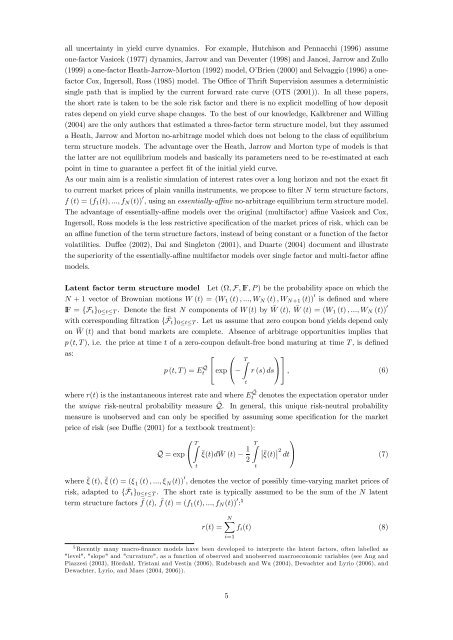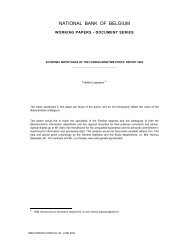A multi-factor model for the valuation and risk management of ...
A multi-factor model for the valuation and risk management of ...
A multi-factor model for the valuation and risk management of ...
Create successful ePaper yourself
Turn your PDF publications into a flip-book with our unique Google optimized e-Paper software.
all uncertainty in yield curve dynamics. For example, Hutchison <strong>and</strong> Pennacchi (1996) assume<br />
one-<strong>factor</strong> Vasicek (1977) dynamics, Jarrow <strong>and</strong> van Deventer (1998) <strong>and</strong> Janosi, Jarrow <strong>and</strong> Zullo<br />
(1999) a one-<strong>factor</strong> Heath-Jarrow-Morton (1992) <strong>model</strong>, O’Brien (2000) <strong>and</strong> Selvaggio (1996) a one<strong>factor</strong><br />
Cox, Ingersoll, Ross (1985) <strong>model</strong>. The O¢ ce <strong>of</strong> Thrift Supervision assumes a deterministic<br />
single path that is implied by <strong>the</strong> current <strong>for</strong>ward rate curve (OTS (2001)). In all <strong>the</strong>se papers,<br />
<strong>the</strong> short rate is taken to be <strong>the</strong> sole <strong>risk</strong> <strong>factor</strong> <strong>and</strong> <strong>the</strong>re is no explicit <strong>model</strong>ling <strong>of</strong> how deposit<br />
rates depend on yield curve shape changes. To <strong>the</strong> best <strong>of</strong> our knowledge, Kalkbrener <strong>and</strong> Willing<br />
(2004) are <strong>the</strong> only authors that estimated a three-<strong>factor</strong> term structure <strong>model</strong>, but <strong>the</strong>y assumed<br />
a Heath, Jarrow <strong>and</strong> Morton no-arbitrage <strong>model</strong> which does not belong to <strong>the</strong> class <strong>of</strong> equilibrium<br />
term structure <strong>model</strong>s. The advantage over <strong>the</strong> Heath, Jarrow <strong>and</strong> Morton type <strong>of</strong> <strong>model</strong>s is that<br />
<strong>the</strong> latter are not equilibrium <strong>model</strong>s <strong>and</strong> basically its parameters need to be re-estimated at each<br />
point in time to guarantee a perfect …t <strong>of</strong> <strong>the</strong> initial yield curve.<br />
As our main aim is a realistic simulation <strong>of</strong> interest rates over a long horizon <strong>and</strong> not <strong>the</strong> exact …t<br />
to current market prices <strong>of</strong> plain vanilla instruments, we propose to …lter N term structure <strong>factor</strong>s,<br />
f (t) = (f 1 (t); :::; f N (t)) 0 , using an essentially-a¢ ne no-arbitrage equilibrium term structure <strong>model</strong>.<br />
The advantage <strong>of</strong> essentially-a¢ ne <strong>model</strong>s over <strong>the</strong> original (<strong>multi</strong><strong>factor</strong>) a¢ ne Vasicek <strong>and</strong> Cox,<br />
Ingersoll, Ross <strong>model</strong>s is <strong>the</strong> less restrictive speci…cation <strong>of</strong> <strong>the</strong> market prices <strong>of</strong> <strong>risk</strong>, which can be<br />
an a¢ ne function <strong>of</strong> <strong>the</strong> term structure <strong>factor</strong>s, instead <strong>of</strong> being constant or a function <strong>of</strong> <strong>the</strong> <strong>factor</strong><br />
volatilities. Du¤ee (2002), Dai <strong>and</strong> Singleton (2001), <strong>and</strong> Duarte (2004) document <strong>and</strong> illustrate<br />
<strong>the</strong> superiority <strong>of</strong> <strong>the</strong> essentially-a¢ ne <strong>multi</strong><strong>factor</strong> <strong>model</strong>s over single <strong>factor</strong> <strong>and</strong> <strong>multi</strong>-<strong>factor</strong> a¢ ne<br />
<strong>model</strong>s.<br />
Latent <strong>factor</strong> term structure <strong>model</strong> Let (; F; IF; P ) be <strong>the</strong> probability space on which <strong>the</strong><br />
N + 1 vector <strong>of</strong> Brownian motions W (t) = (W 1 (t) ; :::; W N (t) ; W N+1 (t)) 0 is de…ned <strong>and</strong> where<br />
IF = fF t g 0tT . Denote <strong>the</strong> …rst N components <strong>of</strong> W (t) by W (t), W (t) = (W1 (t) ; :::; W N (t)) 0<br />
with corresponding …ltration fF t g 0tT . Let us assume that zero coupon bond yields depend only<br />
on W (t) <strong>and</strong> that bond markets are complete. Absence <strong>of</strong> arbitrage opportunities implies that<br />
p (t; T ), i.e. <strong>the</strong> price at time t <strong>of</strong> a zero-coupon default-free bond maturing at time T , is de…ned<br />
as:<br />
2 0<br />
13<br />
TZ<br />
Q<br />
p (t; T ) = E t<br />
4 exp @ r (s) dsA5 ; (6)<br />
Q<br />
where r(t) is <strong>the</strong> instantaneous interest rate <strong>and</strong> where E t denotes <strong>the</strong> expectation operator under<br />
<strong>the</strong> unique <strong>risk</strong>-neutral probability measure Q. In general, this unique <strong>risk</strong>-neutral probability<br />
measure is unobserved <strong>and</strong> can only be speci…ed by assuming some speci…cation <strong>for</strong> <strong>the</strong> market<br />
price <strong>of</strong> <strong>risk</strong> (see Du¢ e (2001) <strong>for</strong> a textbook treatment):<br />
0<br />
TZ<br />
Q = exp @<br />
t<br />
(t)d W (t)<br />
1<br />
2<br />
t<br />
TZ<br />
t<br />
1<br />
<br />
(t) 2<br />
dt A (7)<br />
where (t), (t) = ( 1 (t) ; :::; N (t)) 0 , denotes <strong>the</strong> vector <strong>of</strong> possibly time-varying market prices <strong>of</strong><br />
<strong>risk</strong>, adapted to f F t g 0tT . The short rate is typically assumed to be <strong>the</strong> sum <strong>of</strong> <strong>the</strong> N latent<br />
term structure <strong>factor</strong>s f (t), f (t) = (f 1 (t); :::; f N (t)) 0 : 5<br />
r(t) =<br />
NX<br />
f i (t) (8)<br />
i=1<br />
5 Recently many macro-…nance <strong>model</strong>s have been developed to interprete <strong>the</strong> latent <strong>factor</strong>s, <strong>of</strong>ten labelled as<br />
"level", "slope" <strong>and</strong> "curvature", as a function <strong>of</strong> observed <strong>and</strong> unobserved macroeconomic variables (see Ang <strong>and</strong><br />
Piazzesi (2003), Hördahl, Tristani <strong>and</strong> Vestin (2006), Rudebusch <strong>and</strong> Wu (2004), Dewachter <strong>and</strong> Lyrio (2006), <strong>and</strong><br />
Dewachter, Lyrio, <strong>and</strong> Maes (2004, 2006)).<br />
5
















